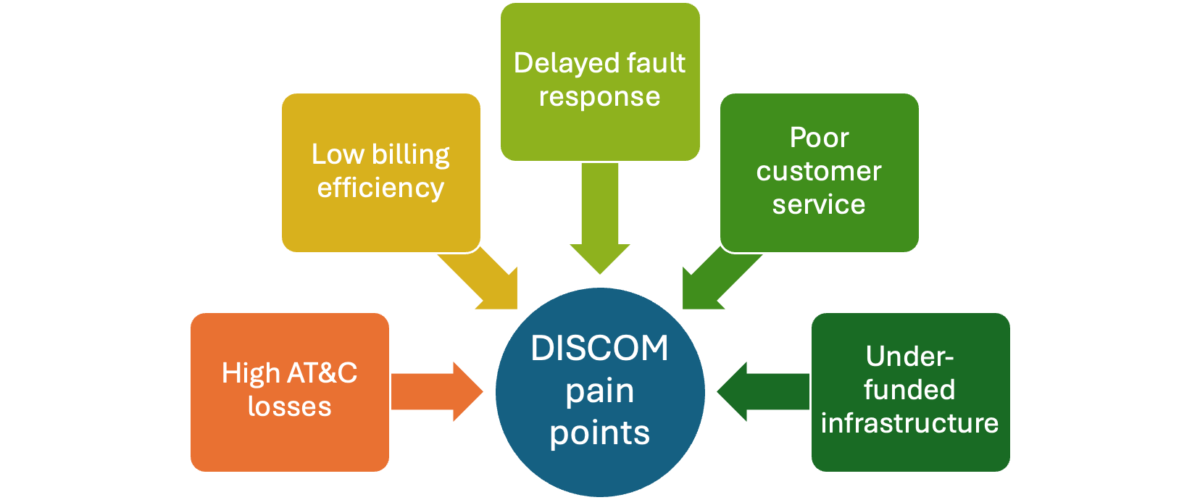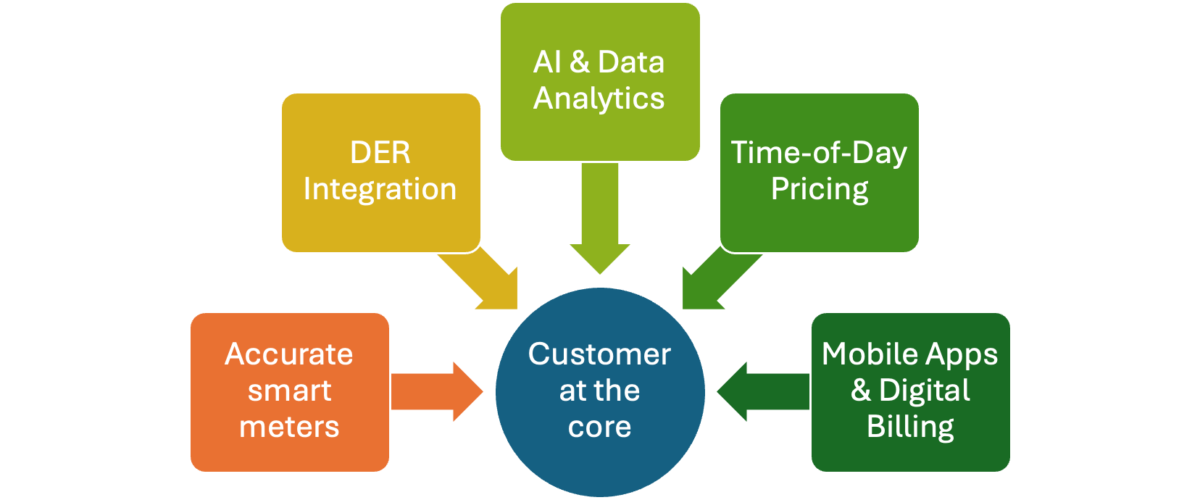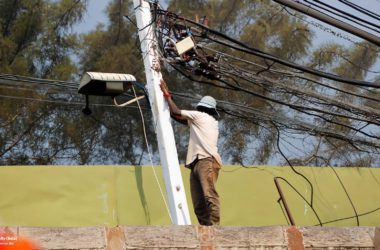Table of Contents Show
Power distribution—the last mile in the electricity value chain—plays a critical role in ensuring that homes, businesses, and industries receive reliable and affordable electricity. Yet, in many countries, this segment remains plagued by high losses, poor customer service, and underinvestment.
In response, a growing number of governments are exploring privatisation or enhanced private sector participation in power distribution as a strategy to improve efficiency, attract investment, and enhance service delivery. This trend is gaining particular traction in countries like India, Nigeria, and Bangladesh, where the need to modernize and expand the distribution network is urgent.
Why Privatization in Power Distribution?
Several structural challenges have created a compelling case for privatisation in power distribution:
- Chronic financial stress: Many government-run distribution companies (DISCOMs) operate at a loss, burdened by high Aggregate Technical and Commercial (AT&C) losses, inefficient billing, and poor collections.
- High technical and commercial losses: Outdated infrastructure, electricity theft, and poor metering practices contribute to unsustainable loss levels—often exceeding 30% in some regions.
- Inadequate investment capacity: Public sector utilities struggle to find funds to modernize their networks or adopt emerging technologies like smart meters and grid automation.
- Rising demand and customer expectations: Consumers now demand 24×7 supply, digital services, and transparency, which many legacy utilities are unable to deliver efficiently.
Privatization offers a potential pathway to address these challenges by bringing in private capital, operational discipline, and customer focus.

Efficiency Gains: The Delhi Experience and Beyond
One of the most cited success stories in power distribution privatization is Delhi. In 2002, the government unbundled and privatised the distribution segment, bringing in companies like Tata Power and Reliance (later BSES).
The results were dramatic:
- AT&C losses reduced from over 50% to under 15% in just over a decade.
- Billing and collection efficiency improved significantly through the use of digital systems.
- Customer satisfaction rose, with better outage management, faster complaint redressal, and digital billing options.
Other models like input-based franchises in states such as Odisha, Bihar, and Madhya Pradesh also showed promise, with private players taking over operations and bringing measurable improvements in metering, billing, and loss reduction.
“Privatization brought in the necessary accountability and customer focus that was missing in the public regime.”
— Former Delhi Electricity Regulatory Commission Official
Unlocking Investment and Technology
Modernizing the power distribution sector requires substantial capital investment—not just for replacing ageing infrastructure, but also for:
- Rolling out smart meters and Advanced Metering Infrastructure (AMI)
- Building robust SCADA systems for real-time monitoring
- Integrating Distributed Energy Resources (DERs) like rooftop solar
- Implementing Demand Response (DR) programs and time-of-day tariffs
Private players are better positioned to make such investments, often leveraging global partnerships and technology solutions. They also bring risk management frameworks, supply chain efficiency, and project execution capabilities that are difficult to replicate in the public sector.
Enhancing Service Delivery for End-Users
Privatised or franchise-based models typically bring a customer-first mindset, emphasizing:
- Reliable supply and outage management
- Prompt response to service requests
- Digitized billing, payments, and mobile apps
- Clear escalation paths for complaints
For example, Tata Power Delhi Distribution Ltd (TPDDL) offers real-time outage notifications, WhatsApp billing services, and AI-based demand forecasting—enhancing both operational efficiency and customer satisfaction.
Such improvements are not just cosmetic; they directly impact consumer trust, payment behavior, and overall system sustainability.
| Parameter | Pre-2002 (Public) | Post 2002 (Private) |
|---|---|---|
| Complaint resolution | 48–72 hrs | <24 hrs |
| Billing Accuracy | 85% | 99%+ |
| Digital Payment Options | None | App, Web, Wallets |
| Outage Communication | Manual | Real-time SMS/App |
Challenges in Power Distribution Privatization
Despite its potential, privatisation in power distribution has faced headwinds:
- Political resistance: Electricity is a politically sensitive subject. Tariff hikes, even when justified, can trigger public backlash.
- Employee concerns: Transitions often lead to fear of job losses and resistance from trade unions.
- Regulatory readiness: Privatization requires robust and independent regulation to ensure fairness, performance enforcement, and consumer protection.
- Mixed results in some states: Odisha’s early experiments with privatization faced initial setbacks, although they’ve since seen improvements with new operators.
These challenges underscore the need for careful planning, stakeholder consultation, and adaptive models.
Newer Approaches: Franchises, TOT, and Smart PPPs
Full privatization isn’t the only path. Several innovative models are now being deployed:
- Input-Based Distribution Franchises: Private players operate the network for a fee or share of revenue, taking responsibility for metering, billing, and collection.
- TOT (Transfer of Technology) and Management Contracts: Utilities retain ownership but outsource operations to private experts.
- Public-Private Joint Ventures: Combining public ownership with private operational efficiency.
For example, Madhya Pradesh’s franchise model has helped reduce losses in difficult geographies, while Odisha’s distribution privatization under the Tata group is being closely watched as a new benchmark.
| Model | Ownership | Operations | Risk to government | Examples |
|---|---|---|---|---|
| Full Privatization | Private | Private | Low | Delhi (India) |
| Input-Based Franchise | Public | Private | Medium | MP, Bihar (India) |
| Management Contract | Public | Private | Medium – High | Various African cities |
| PPP Joint Ventures | Shared | Shared | Low – Medium | Odisha (India – Tata) |
The Road Ahead: Smart, Green, and Customer-Centric
With the power sector undergoing digital transformation and decarbonization, the future of distribution will revolve around:
- Digital infrastructure: AI, IoT, and data analytics for grid management
- DER integration: Managing rooftop solar, batteries, and EVs at the consumer end
- Consumer empowerment: Prepaid meters, time-of-use pricing, net metering
- Green reliability: Powering cities with clean energy, even during peak hours
Private players—with access to global innovation and financing—are critical to accelerating this transition. However, their success depends on policy stability, regulatory strength, and a commitment to universal access.

Conclusion
Privatisation in power distribution is not a silver bullet—but when done right, it can drive efficiency, investment, and service quality in a sector that is foundational to economic growth and human development.
As more governments explore reform, the focus must shift from “who owns the wires” to “how well are services delivered.” Whether through full privatization, PPPs, or hybrid models, the goal must remain the same: a modern, efficient, and equitable power distribution system for all.






